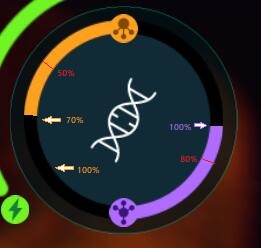In my opinion, the concentration of dissolved substances in water should be relatively stable, and clouds should represent local material enrichment caused by events, and gradually dissipate. For example, cell injury or death leads to nutrient efflux, mineral dissolution. So I admire environmental compounds.
I have thought about the idea of cells completing a single reproduction:
Organelle replication
I still request to modify the mechanism of replicating Organelle with cell growth during the game. This essentially breaks the player’s expected design for cells, causing them to deform, especially because the replication of flagella and nitrogen fixation causes the ATP balance of cells to be disrupted and starve to death.
At present, every time Organelle division occurs, the actual Organelle of the cell is actually increased. The new Organelle will be generated outside the cell without being predicted by the player, which greatly affects the shape of the cell and requires the re statistics of biochemical processes in the game (does this calculation affect the game performance to some extent?).
In my opinion, the shape and function of cells should be expected and determined in the editor as far as possible, and the division of Organelle should be just a visual effect. For cell growth, a fixed form of cell can be demonstrated by zooming in from small to large. This process can be accompanied by changes in engulf capacity, as well as proportional adjustments to material and ATP requirements based on current size.
For binary fission, Organelle can not follow the amplification, but copy themselves and overlap, which also facilitates the possible cell division animation to allocate Organelle.
Nutritional cost [Structural cost]
In my opinion, the nutrition cost represents the component of a Organelle, which is related to the nutrition that a cell needs to synthesize the Organelle and the nutrition that can be obtained by swallowing a Organelle.
Starting from a simple model, only proteins and DNA are considered, corresponding to nitrogen and phosphate (perhaps some special structures should require special compounds, as well as membrane phosphate [phospholipids]). The demand for protein is related to the type and quantity of cell structure, while the demand for DNA is related to the complexity of genes (the complexity of genes can be determined by the type of cell structure, with little impact on quantity, which may promote specialization).
Growth state and Reproductive state
The nutritional cost of designing cells within the editor is set at 100%. For a binary session, it can be divided into cell growth state and reproductive state. Cell proteins in the growth state range from 70%(start state) to 100% and do not synthesize DNA; The proliferation state of cells ranges from 100% to 140% in protein and from 100% to 200% in DNA.

This nutrient pool represents the structural material composition of cells and affects the amount of nutrients that can be provided in addition to stored nutrients when cells are engulfed. I also envisioned that cell damage would result in a loss of progress that needs to be repaired, and excessive loss to the danger line would lead to death. May this serve as a difficult mode?
Growth state, the consumption and output of various biochemical processes in cells are related to the current cell size ratio, in order to avoid a small cell requiring significant material consumption. Reproductive state, The consumption and output of various biochemical processes in cells are calculated at 100% state.
Dormancy and activity of cells
I’ve been thinking about how to reflect this: Nighttime cell dormancy, cell dormancy in the absence of food; Cells are active when food is abundant.
If the process of entering ammonia and phosphate into the progress is considered as a requirement for energy consumption, or the DNA and protein synthesis process that consumes ATP (which can directly give engulf the advantage of some proteins), and the process can be controlled in different stages:
| Stage | Feature |
|---|---|
| Dormancy | Completely no growth and reproduction; closing the motor organs, only basic movement values; reduce osmotic regulation consumption; Close the production of mucus and toxins |
| Energy conservation | Low growth and reproduction; using the motor organs; Close the production of mucus and toxins |
| Normal | Standard State |
| Activity | ATP is consumed in large quantities (except for Glycolysis), so as to grow and reproduce as high as possible (there is a certain upper limit, which is proportional to the normal ratio) |
It may be necessary to classify various biochemical processes.
